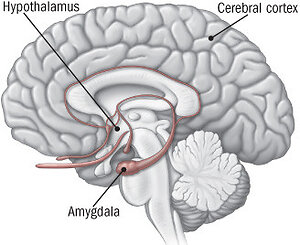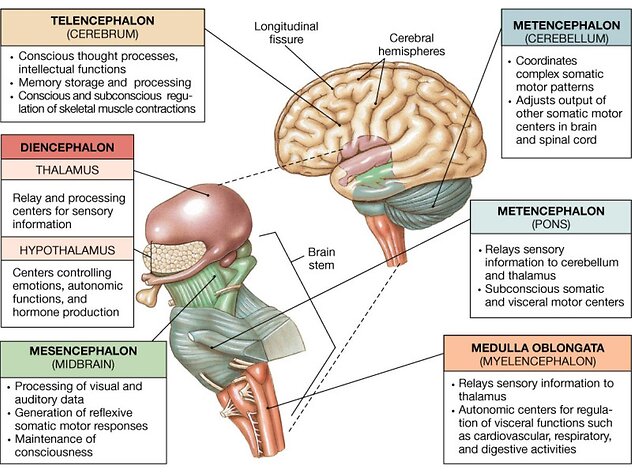
The neuroscience behind anxiety and fear and why you aren't able to stop it yourself
Anxiety happens when a part of the brain, called the amygdala, senses trouble. When it senses threat, either a real threat or even an imagined one, like having to stand up in front of an audience and speak, it sets off a reaction that leads to a release of a hormones that in a survival situation help make the body strong and powerful, so you can fight or run fast.
The brain is constantly trying to keep you safe, so it is continually monitoring your surroundings as well as trying to predict what is going to happen next. There are multiple brain networks and specific brain chemicals involved in this constant readjustment of “prediction and prediction error."
Several areas in the brain are involved in threat detection. Firstly the HPA axis, which stands for Hypothalamic Pituitary Adrenal axis.
This consists of the Hypothalamus – which is a collection of neurons, or nerve cells, deep in base of brain, and it controls things like thirst, hunger and mating. The Hypothalamus releases something called Corticotropin-releasing hormone (CRH) which stimulates the anterior Pituitary to release adrenocorticotropic hormone (ACTH). ACTH then acts on its target organ, the adrenal cortex to produce adrenaline and cortisol.
The adrenals receive signals by way of neurons to release these hormones that make you alert and ready to go. But these chemicals have both a fast component and also a long-latency, ie; a longer lasting component, which is why the feeling of anxiety can last more than a few moments.
The Amygdala is an almond-shaped mass of nuclei (mass of cells) located deep within the temporal lobes of the brain. There are two Amygdalae, one situated in each brain hemisphere. The term Amygdala comes from Latin and translates to "almond," because one of the most prominent nuclei of the Amygdala has an almond-like shape.
It is this collection of nuclei that is involved in the threat reflex. And this circuitry is essentially a memory system. Some of our memories are protective but others are of course not helpful, but it cannot differentiate what is useful to you or not, so regardless the memories can cause an activation of the threat reflex.
There is a process in our nervous system called ‘Neuroplasticity’ which is in essence the nervous system's ability to change in response to experience – but at a cellular level this occurs through a couple of different mechanisms.
One of the main mechanisms is called ‘Long term potentiation’ (LTP) which involves the strengthening of particular connections between neurons, the connection sites between neurons we call synapses, although technically the synapse are the gaps between those connections, but synapses are the points of communication between neurons and these can be strengthened, so that those neurons can talk to other neurons more robustly. So in other words, the pathways, or connections, get stronger and faster, so your response to something begins to feel automatic because it happens at lightening speed.
We can use this learning process within the brain to change the threat detection response. We don't want to just extinguish it however, we also want to replace it with something else, so that it create a lasting change. So you need to attach and replace the fear response with a new response - and this is essentially what we do in the therapy sessions - we are just using your brain's own natural learning processes, but we do it very very quickly.
Watch the video to see the brain cells communicating here Brain cells communicating

How we actually make the change is pretty simple.
So we know the brain is constantly checking our surroundings for threats.
During this processing of checking, if something doesn't feel right the brain has a brief 'wait state', where it requires more information to decide if the situation is safe or not safe - this is often referred to as the 'freeze' response. Sometimes people report in a traumatic event that they were 'frozen with fear' and couldn't move - so they didn't get beyond the freeze state.
It is this 'Freeze' response, that we induce therapeutically and without trauma. We then use the primary communication processes of the early brain to reorganise and neutralise the response associated with the presenting symptom.
So we are essentially imbedding a more appropriate response (chosen by yourself) at the vital moment, so that the brain accepts the 'preferred response' as valid and this becomes the new response in the future.
The process is fairly simple to execute - it does however require an amount of analytical preparation.
This analysis and preparation is done by Sarah during the intake session, where she will go through a thorough and detailed history with you. This then enables Sarah to work out exactly what is happening in your particular situation and why - and from this information she will be able to create the precise structure of the therapy necessary for you, in terms of the specifics required to resolve your individual issues.
So the whole process is based on neuroplasticity, which is the brains ability to create new pathways. This is a natural process that is continually happening within your brain. Every time you learn something new, your brain builds a new pathway - and it is this natural process that we are utilising.
See the process in action here Neuroplasticity
The understanding that we can make changes in the brain is supported by several lines of research.
Kandel, the famous American neuropsychiatrist and the recipient of the 2000 Nobel Prize in physiology/medicine for his research on the physiological basis of memory storage in neurons, had laid down the basic foundations for the neural basis of mental functions.
His work has formed the backbone of our understanding of neurosciences in psychotherapy.
All mental processes, even the most complex psychological processes, derive from operations of the brain
Learning changes neural connections: There are alterations in neural functions induced by experience and learning giving rise to changes in the patterns of neuronal connections as well as behaviour.
